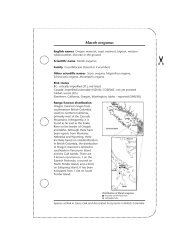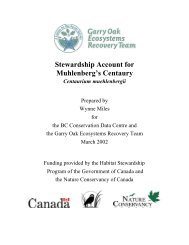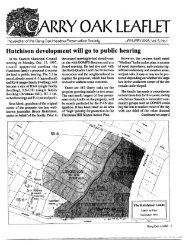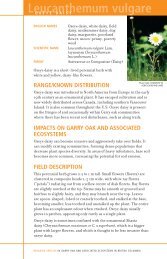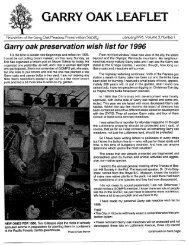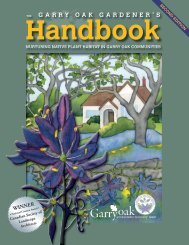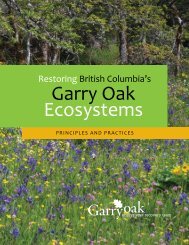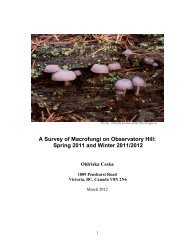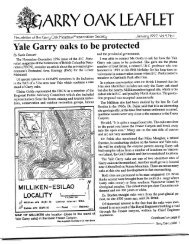PDF 320KB - Garry Oak Ecosystems Recovery Team
PDF 320KB - Garry Oak Ecosystems Recovery Team
PDF 320KB - Garry Oak Ecosystems Recovery Team
You also want an ePaper? Increase the reach of your titles
YUMPU automatically turns print PDFs into web optimized ePapers that Google loves.
Research Colloquium 2010<br />
Proceedings<br />
Pacific Forestry Centre<br />
Canadian Forest Service<br />
506 West Burnside Road<br />
Victoria, BC, Canada<br />
Photo by Chris Junck<br />
March 4, 2010
Table of Contents<br />
RARE SPECIES BIOLOGY ................................................................. 6<br />
A COMPARATIVE ANALYSIS OF THE EPIPHYTE COMMUNITIES FOUND<br />
ON GARRY OAK BARK AT THE COWICHAN GARRY OAK PRESERVE AND<br />
THE LANSDOWNE CAMPUS OF CAMOSUN COLLEGE ............................... 6<br />
ANNE ANDERSON AND ANGELA LOUGHEED ............................................................................................. 6<br />
MACOUN’S MEADOWFOAM (LIMNANTHES MACOUNII): “CANARY IN A<br />
COAL MINE”................................................................................................ 8<br />
ADOLF CESKA ............................................................................................................................................ 8<br />
RARE BRYOPHYTES OF GARRY OAK ECOSYSTEMS .................................. 9<br />
TERRY MCINTOSH, PHD ........................................................................................................................... 9<br />
FIELD STUDIES OF THE LARVAL BIOLOGY OF PROPERTIUS DUSKYWING<br />
(ERYNNIS PROPERTIUS)...........................................................................10<br />
DEVIN METHVEN AND DAVID CLEMENTS............................................................................................... 10<br />
WILL CLIMATE CHANGE DISRUPT BIO-CONTROL OF WINTER MOTH ON<br />
GARRY OAK?.............................................................................................. 11<br />
JENS ROLAND.......................................................................................................................................... 11<br />
INVASIVE SPECIES EFFECTS ........................................................ 12<br />
ECOLOGY, BIOLOGY AND CONTROL OF SOME EXOTIC-INVASIVE WEEDS<br />
ON FEDERAL LANDS IN BRITISH COLUMBIA, CANADA .......................... 12<br />
RAJ PRASAD, J. BENNER AND S. BUNDEL............................................................................................... 12<br />
PLANT-MEDIATED IMPACT OF AN INVASIVE OAK-GALL WASP ON A<br />
NATIVE SPECIALIST BUTTERFLY: ERYNNIS PROPERTIUS .....................14<br />
KIRSTEN M. PRIOR AND JESSICA J. HELLMAN....................................................................................... 14<br />
ECOSYSTEM CLASSIFICATION AND FUNCTION ..................16<br />
PATTERNS IN NATIVE AND INTRODUCED PLANT SPECIES IN GARRY<br />
OAK MEADOWS: IMPLICATIONS FOR FUTURE TRENDS AND EFFECTIVE<br />
MANAGEMENT...........................................................................................16<br />
JOSEPH R. BENNETT, PATRICK LILLEY, MARK VELLEND, AND PETER ARCESE..................................... 16<br />
FIVE YEARS OF FUNGI SURVEYS ON OBSERVATORY HILL, VICTORIA...18<br />
OLUNA CESKA.......................................................................................................................................... 18<br />
DETECTING CHANGES IN GARRY OAK VEGETATION PLOTS AFTER 4<br />
DECADES: FOLLOWING IN DR. HANS ROEMER’S FOOTSTEPS................ 19<br />
JENNY MCCUNE ...................................................................................................................................... 19<br />
RESTORATION ................................................................................... 20<br />
<strong>Garry</strong> <strong>Oak</strong> <strong>Ecosystems</strong> <strong>Recovery</strong> <strong>Team</strong> – Research Colloquium 2010 Page 2
SOUTH PUGET SOUND PRAIRIES 2009 CONSERVATION ACTIONS........ 20<br />
A BRIEF SUMMARY................................................................................... 20<br />
HANNAH ANDERSON............................................................................................................................... 20<br />
PRESCRIBED FIRE AT THE COWICHAN GARRY OAK PRESERVE - SEPT 15,<br />
2010............................................................................................................22<br />
IRVIN BANMAN ........................................................................................................................................ 22<br />
SOCIAL CAPITAL: BUILDING CAPACITY TO SUSTAIN URBAN<br />
BIODIVERSITY THROUGH ECOLOGICAL RESTORATION ....................... 24<br />
NATHALIE DECHAINE.............................................................................................................................. 24<br />
EXPERIMENTAL TRANSLOCATION OF GOLDEN PAINTBRUSH<br />
(CASTILLEJA LEVISECTA) TO GULF ISLANDS NATIONAL PARK RESERVE<br />
....................................................................................................................25<br />
AIMEE PELLETIER ................................................................................................................................... 25<br />
INTRODUCING TRADITIONAL BLUE CAMAS (CAMASSIA LEICHTLINII<br />
AND C. QUAMASH) CULTIVATION PRACTICES INTO A GARRY OAK<br />
(QUERCUS GARRYANA) MEADOW PRESERVE IN BRITISH COLUMBIA. 26<br />
KATE PROCTOR........................................................................................................................................ 26<br />
ADDITIONAL PUBLICATIONS OF INTEREST............................................ 29<br />
<strong>Garry</strong> <strong>Oak</strong> <strong>Ecosystems</strong> <strong>Recovery</strong> <strong>Team</strong> – Research Colloquium 2010 Page 3
Presenters’ Contacts<br />
Anne Anderson<br />
BSc in Environmental Science student<br />
Royal Roads University<br />
Victoria, BC<br />
anne.anderson44@gmail.com<br />
Hannah Anderson<br />
The Nature Conservancy<br />
Olympia, WA<br />
360-701-8803 (phone) / handerson@tnc.org<br />
Irvin Banman<br />
Cowichan <strong>Garry</strong> <strong>Oak</strong> Preserve, Nature Conservancy of Canada<br />
Duncan, BC<br />
irvin.banman@natureconservancy.ca<br />
Joseph R. Bennett<br />
Centre for Applied Conservation Research, Faculty of Forestry<br />
University of British Columbia, 2424 Main Mall, Vancouver BC V6T 1Z4<br />
jrb5@interchange.ubc.ca<br />
Adolf and Oluna Ceska<br />
P.O. Box 8546, Victoria, BC V8W 3S2<br />
250-477-1211 / 250-216-1481 (mobile) / aceska@telus.net<br />
David Clements<br />
Biology and Environmental Studies, Trinity Western University<br />
7600 Glover Rd. Langley, BC V2Y 1Y1<br />
604-513-2121 ext. 3280 / 604-513-2018 (fax) /clements@twu.ca<br />
Nathalie Dechaine<br />
Victoria, BC<br />
nathaliedechaine@hotmail.com<br />
Angela Lougheed<br />
BSc in Environmental Science student<br />
Royal Roads University<br />
ange_lougheed@hotmail.com<br />
Jenny McCune<br />
Department of Botany, University of British Columbia<br />
Vancouver, BC<br />
jmccune@interchange.ubc.ca<br />
<strong>Garry</strong> <strong>Oak</strong> <strong>Ecosystems</strong> <strong>Recovery</strong> <strong>Team</strong> – Research Colloquium 2010 Page 4
Terry McIntosh<br />
Vancouver, BC<br />
ttmcintosh@shaw.ca / 778-968-4101 (cell)<br />
Devin Methven<br />
Biology and Environmental Studies, Trinity Western University<br />
600 Glover Rd. Langley, BC V2Y 1Y1<br />
Aimee Pelletier<br />
Parks Canada Agency -- Coastal BC Field Unit Fort Rodd Hill National<br />
Historic Site of Canada<br />
603 Fort Rodd Hill Road, Victoria, BC V9C 2W8<br />
250-478-5118 / 250-208-3844 (cell) /250-478-8415 (fax)/<br />
aimee.pelletier@pc.gc.ca<br />
Raj Prasad, Ph.D.<br />
Research Scientist<br />
Retired from the Pacific Forestry Centre, Victoria, BC<br />
arailprasad@gmail.com /250- 385- 2306<br />
Kirsten Prior<br />
Department of Biological Sciences, University of Notre Dame<br />
107 Galvin Life Science Center, Notre Dame, IN 46556<br />
kprior1@nd.edu<br />
Kate Proctor<br />
School of Environmental Studies, University of Victoria<br />
Victoria, BC<br />
kproctor@uvic.ca<br />
Jens Roland<br />
Department of Biological Sciences<br />
University of Alberta, Edmonton, AB T6G 2E9<br />
jroland@ualberta.ca<br />
<strong>Garry</strong> <strong>Oak</strong> <strong>Ecosystems</strong> <strong>Recovery</strong> <strong>Team</strong> – Research Colloquium 2010 Page 5
RARE SPECIES BIOLOGY<br />
A COMPARATIVE ANALYSIS OF THE EPIPHYTE<br />
COMMUNITIES FOUND ON GARRY OAK BARK AT<br />
THE COWICHAN GARRY OAK PRESERVE AND<br />
THE LANSDOWNE CAMPUS OF CAMOSUN<br />
COLLEGE<br />
Anne Anderson and Angela Lougheed<br />
Royal Roads University<br />
Very little is known about epiphytic populations on <strong>Garry</strong> oak.<br />
Therefore, the purpose of this study is to broaden the scientific<br />
community’s knowledge regarding epiphytic populations found on<br />
the trunks of <strong>Garry</strong> oak trees. The report details the study of epiphyte<br />
population distributions on <strong>Garry</strong> oak trunks at the two sites. The<br />
report includes multivariate analysis using PCORD and Minitab<br />
statistical software to compare the abundance and diversity of<br />
epiphytes on <strong>Garry</strong> oak bark on three different levels:<br />
1. Between the two sites<br />
2. Between the cardinal directions of the trees<br />
3. Between the tree’s size classes within each site<br />
Methodology for the experiment involved a sample design of eight<br />
trees with two size classes at each site. The “small” size class included<br />
trees with circumferences between 1.0 m and 1.5 m; trees with<br />
circumferences greater than 1.5 m were in the “large” size class.<br />
Trunks were sampled at a height of 1.3 m using 10 cm x 10 cm square<br />
mesh grids; each grid was one cm 2 . Three grids were placed per<br />
cardinal direction of the tree (sample unit). A sequential sampling<br />
design (i.e., alternating intersections) of 50 intersections per grid was<br />
chosen. A sewing needle was inserted at the upper right corner of the<br />
marked intersection on the grid, and the epiphyte touched by the pin<br />
was recorded. The data collected were analyzed using various<br />
statistical tests.<br />
<strong>Garry</strong> <strong>Oak</strong> <strong>Ecosystems</strong> <strong>Recovery</strong> <strong>Team</strong> – Research Colloquium 2010 Page 6
The data were found to have a right-skewed distribution; therefore, a<br />
Kruskal-Wallis test was used to test for significant differences in the<br />
mean percent cover of epiphytes between the sites. This analysis<br />
showed that there was no significant difference between the sites in<br />
regards to mean percent cover. The alpha diversity analysis revealed<br />
several patterns in the data. Overall, it was found that the Lansdowne<br />
site had greater species richness and evenness than the Cowichan<br />
(Maple Bay) site. The comparison between the cardinal directions<br />
showed that the west sides of the trees at the Lansdowne site had<br />
greater species richness and lower evenness. However, at the<br />
Cowichan (Maple Bay) site, north sides of the trees had greater<br />
species richness and lower evenness. The size-class comparison<br />
revealed that smaller trees at Lansdowne had higher species richness<br />
and evenness than trees in the larger size class. Comparison at the<br />
Cowichan (Maple Bay) site revealed the opposite; larger trees had<br />
slightly higher values for species richness and evenness. A two-wayordered<br />
TWINSPAN analysis separated the species into two groups<br />
based on their abundance characteristics. This analysis also grouped<br />
sample units with other sample units within the site that had similar<br />
abundance and diversity characteristics. With the exception of a few<br />
anomalous sample units, we found a distinct separation in species<br />
abundance and diversity between the sites. A cluster analysis<br />
produced a dendrogram that illustrated the two distinct sample unit<br />
groups. Reciprocal averaging analysis supported the findings of the<br />
TWINSPAN and cluster analyses regarding the separation of the<br />
sample units into two distinct groups (Lansdowne and Cowichan<br />
site).<br />
<strong>Garry</strong> <strong>Oak</strong> <strong>Ecosystems</strong> <strong>Recovery</strong> <strong>Team</strong> – Research Colloquium 2010 Page 7
MACOUN’S MEADOWFOAM (LIMNANTHES<br />
MACOUNII): “CANARY IN A COAL MINE”<br />
Adolf Ceska<br />
Consultant<br />
Macoun’s meadowfoam was first collected by John Macoun “in<br />
ditches at Victoria” - May 7, 1875. It is endemic to southern<br />
Vancouver Island and adjacent islands. In 1956, the same year it was<br />
proclaimed extinct by Hitchcock et al. (Vascular plants of the Pacific<br />
Northwest), it was rediscovered on Trial Island and in <strong>Oak</strong> Bay,<br />
Victoria. In 1998, a large population of a plant that looks like<br />
Macoun’s meadowfoam was found in California in a cabbage field.<br />
Californian plants exhibit striking morphological and physiological<br />
differences, raising a question re their taxonomical relation to our<br />
plants.<br />
In our 1988 COSEWIC Report we reported 52 subpopulations over 24<br />
sites. The 2004 COSEWIC update includes 28 sites. We then<br />
compared the size of the subpopulations, by number of plants,<br />
between 2004 and 1988. From the 52 subpopulations we reported in<br />
our 1988 COSEWIC report, 16 (30.8%) disappeared, 14 (26.9%)<br />
declined, 10 (19.2%) remained the same and 12 (23.1%) increased in<br />
number of individuals. The majority of subpopulations that<br />
disappeared were small subpopulations and most of them were<br />
outcompeted by introduced perennial grasses.<br />
There are two major threats to Macoun’s meadowfoam: human<br />
activities and the competition of introduced grasses and forbs.<br />
Only a small subpopulation of Macoun’s meadowfoam is protected in<br />
the Trial Island Ecological Reserves.<br />
Post scriptum: James Miskelly & Tracy Cornforth found the largest<br />
known population of Macoun’s meadowfoam on Rocky Point at the<br />
firebreak of the DND Ammunition Depot. This population has been<br />
successfully maintained by regular plowing in late spring.<br />
<strong>Garry</strong> <strong>Oak</strong> <strong>Ecosystems</strong> <strong>Recovery</strong> <strong>Team</strong> – Research Colloquium 2010 Page 8
RARE BRYOPHYTES OF GARRY OAK ECOSYSTEMS<br />
Terry McIntosh, PhD<br />
Consultant<br />
Recent studies of bryophytes in <strong>Garry</strong> oak and related ecosystems not<br />
only have been critical in better defining population and other<br />
attributes of known rare species but also have increased the known<br />
regional diversity of this group of plants. At least 18 dry coastal<br />
mosses are listed by BC’s Conservation Data Centre and 3 are listed<br />
on SARA (Species at Risk Act) and COSEWIC (Committee on the<br />
Status of Endangered Wildlife in Canada). A number of others, as well<br />
as a few liverworts, deserve a conservation listing at some point.<br />
Population, distribution, and threat attributes have become much<br />
better understood for a number of rare species, in particular rigid<br />
apple moss (Bartramia stricta). Although only one new population of<br />
rigid apple moss has been observed recently, even with more-intense<br />
inventory, it has been found to be significantly more common and<br />
widespread at known sites than previously documented. Results of<br />
these studies indicate that inventory remains an important aspect of<br />
biodiversity studies in this rich and threatened ecosystem.<br />
<strong>Garry</strong> <strong>Oak</strong> <strong>Ecosystems</strong> <strong>Recovery</strong> <strong>Team</strong> – Research Colloquium 2010 Page 9
FIELD STUDIES OF THE LARVAL BIOLOGY OF<br />
PROPERTIUS DUSKYWING (ERYNNIS<br />
PROPERTIUS)<br />
Devin Methven and David Clements<br />
Trinity Western University<br />
During the summer of 2009 we conducted field studies on the natural<br />
history of a specialist butterfly Erynnis propertius (Lepidoptera:<br />
Hesperiidae), the Propertius duskywing. In an a attempt to determine<br />
the preferred habitat range of this <strong>Garry</strong> oak (Quercus garryana)<br />
specialist, in its northernmost range, enclosures were established in<br />
three meadows (Twin Lichen, Spring Meadow and THB) on Trinity<br />
Western University’s Crow’s Nest Ecological Research Area (CNERA)<br />
on Salt Spring Island. Adult females were captured and placed in the<br />
enclosures, allowing larvae to be raised from eggs through five of the<br />
six instars. These captive observations aided in the accurate larval<br />
identification in the field, which was conducted during the months of<br />
June and July. Transects were established in each of the meadows,<br />
and the inner and outer regions of each <strong>Garry</strong> oak tree were examined<br />
for E. propertius larvae at a variety of heights. We found that E.<br />
propertius larvae represented 13% of the total larval observations;<br />
three other Lepidopteran species were also fairly abundant in our<br />
<strong>Garry</strong> oak transects. The E. propertius larvae “preferred” the outer<br />
most regions of the tree canopy and, were more prevalent at heights<br />
between a range of 2.5 m - 3.0 m from the ground. We also examined<br />
the relationship between the tannin concentrations in Q. garryana<br />
leaves and the “preferred” location E. propertius larvae. These field<br />
studies will aid in developing methods for monitoring E. propertius<br />
on <strong>Garry</strong> oak trees through accurate larval identification. The new<br />
insights on larval feeding behavior represent a step towards<br />
developing recommendations for managing <strong>Garry</strong> oak habitat to<br />
enhance E. propertius populations.<br />
<strong>Garry</strong> <strong>Oak</strong> <strong>Ecosystems</strong> <strong>Recovery</strong> <strong>Team</strong> – Research Colloquium 2010 Page 10
WILL CLIMATE CHANGE DISRUPT BIO-CONTROL<br />
OF WINTER MOTH ON<br />
GARRY OAK?<br />
Jens Roland<br />
University of Alberta<br />
The control of winter moth (Operophtera brumata) in Victoria and<br />
on the Saanich Peninsula, B.C., was attributed to the impact of<br />
parasitism by an introduced tachinid fly and to predation by resident<br />
beetle predators in the soil. Warmer winters favour the early<br />
emergence of the pest winter moth but not of the introduced fly due<br />
to its diapause. Earlier emergence of the pest due to climate warming<br />
may reduce rates of parasitism by the introduced fly due to reduced<br />
synchrony in their respective time of emergence. Reduced moth<br />
mortality due to poor parasite synchrony may allow populations<br />
under control to erupt.<br />
<strong>Garry</strong> <strong>Oak</strong> <strong>Ecosystems</strong> <strong>Recovery</strong> <strong>Team</strong> – Research Colloquium 2010 Page 11
INVASIVE SPECIES EFFECTS<br />
ECOLOGY, BIOLOGY AND CONTROL OF SOME<br />
EXOTIC-INVASIVE WEEDS ON FEDERAL LANDS<br />
IN BRITISH COLUMBIA, CANADA<br />
Raj Prasad, J. Benner and S. Bundel<br />
Formerly with Pacific Forestry Centre, Canadian Forestry Service,<br />
Victoria<br />
Scotch broom (Cytisus scoparius), gorse (Ulex europaeus), daphne<br />
(Daphne laureola) and English ivy (Hedera helix), are four<br />
prominent, invasive plants that pose a serious threat to <strong>Garry</strong> oak and<br />
associated ecosystems on federal lands in Victoria, British Columbia.<br />
These plants colonize disturbed areas quickly, form dense<br />
monospecific stands, remain persistent for a long time and defy any<br />
easy eradication program. They suppress and inhibit the growth of<br />
native plants and ultimately arrest forest succession. Several federal<br />
departments including the Department of Environment, Department<br />
of National Defense, Department of Fisheries and Oceans,<br />
Department of Indian Affairs and Parks Canada have expressed great<br />
concerns regarding their rapid incursion, adverse impacts and the<br />
resulting degradation of native habitats. With a grant from the<br />
Department of Environment and the Department of National<br />
Defense, we conducted research to examine the population dynamics,<br />
phenology and control methods of these invasive plants on federal<br />
lands near Victoria, B.C. Of the methods of control tested, including<br />
manual cutting, application of a registered herbicide (Releasetriclopyr),<br />
a fungal bioherbicide (Chondrostereum purpureum), and a<br />
commercial plastic mulch, it was found that the mulch and herbicide<br />
treatments provided 100% efficacy on reducing resprouting of all<br />
four invasive species. While one bioherbicide (Fusarium tumidum)<br />
was very effective on Scotch broom under greenhouse conditions, it<br />
was not applied under field conditions. The other bioherbicide<br />
(Chondrostereum purpureum) produced a variable response when<br />
applied under field conditions. Manual cutting was found to be the<br />
least effective. A novel prospective bioagent (Phomopsis sp. denovo)<br />
<strong>Garry</strong> <strong>Oak</strong> <strong>Ecosystems</strong> <strong>Recovery</strong> <strong>Team</strong> – Research Colloquium 2010 Page 12
was isolated from dying and dead samples of daphne from the field.<br />
Results from laboratory, greenhouse and field observations suggest<br />
that it may hold great potential for control of daphne. Continued and<br />
additional research is necessary to determine the appropriate<br />
formulations of these bioagents, as well as the effectiveness of the<br />
different and integrated control treatments over a period of years. A<br />
new technology using superheated water (Aquacide) to kill vegetative<br />
shoots of gorse did not offer long term control, nor was it found to be<br />
cost effective.<br />
Key words: alien invasive weeds, bioherbicide, forestry<br />
<strong>Garry</strong> <strong>Oak</strong> <strong>Ecosystems</strong> <strong>Recovery</strong> <strong>Team</strong> – Research Colloquium 2010 Page 13
PLANT-MEDIATED IMPACT OF AN INVASIVE OAK-<br />
GALL WASP ON A NATIVE SPECIALIST<br />
BUTTERFLY: ERYNNIS PROPERTIUS<br />
Kirsten M. Prior and Jessica J. Hellman<br />
University of Notre Dame<br />
A foliar gall-forming wasp, Neuroterus saltatorius, was recently<br />
introduced on to Vancouver Island, British Columbia. In its native<br />
range it occurs at low, non-damaging, levels on its host plant, <strong>Garry</strong><br />
oak (Quercus garryana). In its introduced range, however, it occurs<br />
at much higher densities where it may have substantial impacts on Q.<br />
garryana and associated species, such as the threatened oakspecialist,<br />
the propertius duskywing (Erynnis propertius). Gallformers<br />
can manipulate their host plants in several ways. They can<br />
assimilate nutrients such as nitrogen from plant tissue into their<br />
inner nutritive gall tissue. Also, they can increase the metabolism of<br />
phenols such as tannins and lignin that they concentrate in their<br />
outer protective gall tissue. Despite their ability to manipulate their<br />
host plants, the role of gall-formers as competitors is relatively<br />
unknown. Caterpillars of E. propertius occur on oak leaves<br />
contemporaneously with N. saltatorius galls. We predicted that this<br />
invasive gall-former affects this native butterfly by altering the foliar<br />
quality of oak leaves that caterpillars feed on. In the gall-former’s<br />
introduced range, we stocked enclosures with caterpillars on trees<br />
that varied in gall-former density. Biomass production of butterflies<br />
was lower in enclosures on high-density than on low-density trees<br />
because over-wintering caterpillars were smaller and fewer of them<br />
enclosed into adults the following spring. To see if N. saltatorius<br />
induced changes in foliar quality, we measured host plant quality<br />
before and after gall induction on 30 trees each at two sites<br />
(Government House and Cowichan Preserve). We found a positive<br />
relationship between gall-former density and the percent change in<br />
foliar C:N, a negative relationship between gall-former density and<br />
the percent change in foliar water at Cowichan, and no relationship<br />
between the percent change in protein-binding capacity (i.e.,<br />
phenolics) and gall-former density. Additionally, there was a negative<br />
relationship between foliar nutritional quality and butterfly<br />
performance. Our results provide evidence for a plant-mediated<br />
<strong>Garry</strong> <strong>Oak</strong> <strong>Ecosystems</strong> <strong>Recovery</strong> <strong>Team</strong> – Research Colloquium 2010 Page 14
impact of N. saltatorius on E. propertius suggesting that this gallformer<br />
could acts as a competitor at high densities.<br />
Prior, K.M., J.D.K. Dzurisin, S.L. Pelini, and J.J. Hellmann. 2009.<br />
Biology of larvae and adults of Erynnis propertius at the northern<br />
edge of its range. The Canadian Entomologist<br />
141: 161-171.<br />
Prior, K.M., and J.J. Hellmann. 2010. Plant-mediated impact of an<br />
invasive oak-gall wasp on a specialist butterfly: a test of interspecific<br />
competition with a gall-forming insect. Ecology, in press [doi:<br />
10.1890/09-1314].<br />
<strong>Garry</strong> <strong>Oak</strong> <strong>Ecosystems</strong> <strong>Recovery</strong> <strong>Team</strong> – Research Colloquium 2010 Page 15
ECOSYSTEM CLASSIFICATION AND FUNCTION<br />
PATTERNS IN NATIVE AND INTRODUCED PLANT<br />
SPECIES IN GARRY OAK MEADOWS:<br />
IMPLICATIONS FOR FUTURE TRENDS AND<br />
EFFECTIVE MANAGEMENT<br />
Joseph R. Bennett, Patrick Lilley, Mark Vellend, and Peter<br />
Arcese<br />
University of British Columbia<br />
Invasive introduced species are considered to be a major threat to the<br />
<strong>Garry</strong> <strong>Oak</strong> Ecosystem (GOE). While there is a general consensus that<br />
this threat is probably increasing, there has been no systematic<br />
documentation of patterns of native and introduced species through a<br />
broad range of GOE meadows, nor has it been possible to predict<br />
future trends in introduced species. As part of a broader collaboration<br />
to help understand species distributions in the GOE, we have<br />
summarized synoptic patterns in native and introduced species in<br />
GOE meadows.<br />
We conducted multi-scale surveys on 86 GOE meadows on<br />
Vancouver Island and adjacent islands, including many sites that had<br />
not been previously surveyed. Patches were surveyed through their<br />
full extent for presence of vascular plant species, and were also<br />
surveyed using a total of 602 quadrats for presence and percent cover<br />
of vascular plants at the intra-site scale. We found striking differences<br />
in the representation of native and introduced species. Contrary to<br />
popular conception, native species continue to dominate GOE<br />
meadows. While some meadows near Victoria are composed largely<br />
of introduced species, most are dominated, both in terms of species<br />
richness and percent cover, by native species. Small islands are<br />
particularly well-protected, with some exhibiting >90% relative cover<br />
of native species.<br />
Models of species richness and geographic spread according to<br />
nativeness and long-distance dispersal capacity reveal more ominous<br />
<strong>Garry</strong> <strong>Oak</strong> <strong>Ecosystems</strong> <strong>Recovery</strong> <strong>Team</strong> – Research Colloquium 2010 Page 16
trends. Introduced long-dispersers, on a per-species basis, are more<br />
common on both inter- and intra-site scales than any other type of<br />
species. Despite having been present on the landscape for
FIVE YEARS OF FUNGI SURVEYS ON<br />
OBSERVATORY HILL, VICTORIA<br />
Oluna Ceska<br />
Consultant<br />
In the 2009/2010 season, forty-two visits to Observatory Hill yielded<br />
520 species of macrofungi, of which 139 were found on Observatory<br />
Hill for the first time. Since the start of the survey in November 2004,<br />
the number of species recorded is 900. From the fall of 2005 to the<br />
spring of 2010, mycorrhizal species accounted for 15-27% of the total<br />
number found. Many species found on Observatory Hill have not<br />
been found previously in Canada. The material I collected on<br />
Observatory Hill since the survey began contains at least one<br />
undescribed species. The most interesting finds include: Byssonectria<br />
fusispora, Claudopus byssisedus, Entoloma lignicola, Pouzarella<br />
spp., Leptonia spp., Cytidia stereoides, Marasmius chordalis,<br />
Mycena corynephora, Squamanita paradoxa, Tetrapyrgos<br />
subdendrophora, Tubaria punicea, etc. Results of the Observatory<br />
Hill macrofungi inventory are available at<br />
www.goert.ca/documents/Macrofungi-Observatory-Hill-2009-<br />
2010.pdf and www.goert.ca/documents/Macrofungi-Observatory-<br />
Hill-2008-2009.pdf.<br />
See also www.goert.ca/news/2010/05/12/macrofungi-2004-2010.<br />
<strong>Garry</strong> <strong>Oak</strong> <strong>Ecosystems</strong> <strong>Recovery</strong> <strong>Team</strong> – Research Colloquium 2010 Page 18
DETECTING CHANGES IN GARRY OAK<br />
VEGETATION PLOTS AFTER 4 DECADES:<br />
FOLLOWING IN DR. HANS ROEMER’S FOOTSTEPS<br />
Jenny McCune<br />
University of British Columbia<br />
In order to understand how plant communities are changing in<br />
response to human disturbance, it is useful to have a historical<br />
baseline by which to measure changes. However, such baseline data<br />
are often unavailable for many regions and time periods. On the<br />
Saanich peninsula of Vancouver Island, Dr. Hans Roemer surveyed<br />
over four hundred 20m by 20m relevé plots in the late 1960s as part<br />
of his doctoral research. This provides a unique opportunity to<br />
quantify the changes in vegetation on the Peninsula in the past 40<br />
years. I used Dr. Roemer’s field notes to return to 184 of his plot<br />
locations, 43 of which were in <strong>Garry</strong> oak communities, and<br />
resurveyed them using the same methodology. Preliminary analyses<br />
show that herbaceous plant richness in <strong>Garry</strong> <strong>Oak</strong> plots increased<br />
significantly, from an average of 28.4 species to an average of 33.1<br />
species. The total number of herbaceous species found in <strong>Garry</strong> <strong>Oak</strong><br />
plots increased from 121 in 1968 to 139 in 2009. Exotic species<br />
represented approximately 20% of <strong>Garry</strong> <strong>Oak</strong> herbaceous flora in<br />
1968, increasing to 40% by 2009. I looked for changes in plant<br />
community composition by using Non-Metric Multidimensional<br />
Scaling to ordinate all plots in both years. There seems to have been a<br />
much larger shift in herbaceous plant composition in Douglas-firdominated<br />
communities compared to <strong>Garry</strong> oak-dominated plots. I<br />
hypothesize that this greater change in Douglas-fir-dominated<br />
herbaceous flora may be due to a larger degree of fragmentation of<br />
Douglas-fir forests between 1968 and 2009, whereas many <strong>Garry</strong> oak<br />
plots were located in fragments that have not changed in size since<br />
Dr. Roemer’s survey. Future work will aim to determine the<br />
relationship between vegetation changes and changes in the degree of<br />
human disturbance across the landscape. Using historical data is a<br />
valuable way to gain understanding of vegetation changes, and<br />
researchers today should consider making and keeping detailed notes<br />
on the locations and methodology of their projects in order to provide<br />
a baseline for ecologists of the future.<br />
<strong>Garry</strong> <strong>Oak</strong> <strong>Ecosystems</strong> <strong>Recovery</strong> <strong>Team</strong> – Research Colloquium 2010 Page 19
RESTORATION<br />
SOUTH PUGET SOUND PRAIRIES 2009<br />
CONSERVATION ACTIONS<br />
A BRIEF SUMMARY<br />
Hannah Anderson<br />
Cooperative Conservation Program Manager<br />
The Nature Conservancy<br />
The prairies and oak woodlands of the South Puget Sound are some of<br />
the highest quality and largest acreage of this rare and fragmented<br />
system remaining in the Willamette Valley-Puget Trough-Georgia<br />
Basin Ecoregion. A cooperative of partners including US federal and<br />
state natural resource agencies, non-profit conservation<br />
organizations and the US military are working together to preserve<br />
and restore this fragile system. Our collective work focuses on<br />
general prairie restoration as well as recovery efforts for specific<br />
species, particularly those that are federal candidates for listing under<br />
the ESA (Endangered Species Act): the streaked horned lark, Mazama<br />
pocket gopher, Taylor’s checkerspot butterfly and mardon skipper<br />
butterfly. This presentation will summarize some of the actions<br />
conducted by a wide group of partners. The major threats to the<br />
prairie oak system include human development, fire suppression,<br />
encroachment by conifers and non-native shrubs and grasses.<br />
Partners are working exhaustively to control non-native vegetation<br />
that changes the structure and composition of the grasslands. To<br />
increase our suite of control methods, we are building up a<br />
prescribed-fire program with sufficient infrastructure and trained<br />
firefighters to be able to use controlled burning reliably as a<br />
restoration tool. In 2009, we burned over 130 acres of prairie and<br />
oak woodland sites throughout the Puget Sound. However,<br />
controlling invasives and restoring ecological processes are not<br />
enough. Once an invasive is removed, it must be replaced with native<br />
vegetation. We are growing plants and seeds of a wide variety of<br />
native species and learning the best strategies to ensure their survival<br />
in the field. Ramping up the availability of native seed and our ability<br />
<strong>Garry</strong> <strong>Oak</strong> <strong>Ecosystems</strong> <strong>Recovery</strong> <strong>Team</strong> – Research Colloquium 2010 Page 20
to seed “at scale” is a priority of conservation partners. We are also<br />
conducting significant projects to increase the sizes and numbers of<br />
our rare species populations. A captive breeding and reintroduction<br />
program is in place for the Taylor’s checkerspot butterfly, and we<br />
have seen indications of success with animals flying at release sites.<br />
We are also monitoring the habitat quality and species populations on<br />
sites throughout the South Sound. Through our collective and<br />
cooperative efforts we have seen some positive results, including new<br />
populations of our target species, habitat conditions for<br />
reintroductions being met, and overall improved habitat. We still<br />
have a long way to go, but we are learning new and more efficient<br />
ways to accomplish our goals. Much of the work presented was<br />
funded by the US Department of Defense, US Fish and Wildlife<br />
Service and the Natural Resources Conservation Service, and<br />
implemented by The Nature Conservancy, Washington Department<br />
of Fish and Wildlife, Washington Department of Natural Resources,<br />
University of Washington, Joint Base Lewis-McChord, and a<br />
dedicated group of volunteers.<br />
For more information visit www.southsoundprairies.org.<br />
<strong>Garry</strong> <strong>Oak</strong> <strong>Ecosystems</strong> <strong>Recovery</strong> <strong>Team</strong> – Research Colloquium 2010 Page 21
PRESCRIBED FIRE AT THE COWICHAN GARRY<br />
OAK PRESERVE - SEPT 15, 2010<br />
Irvin Banman<br />
The Nature Conservancy of Canada<br />
The deep-soil <strong>Garry</strong> oak meadows on southeast Vancouver Island<br />
were historically managed by First Nations for camas harvest, as<br />
foraging areas for elk and deer which were hunted, and also for the<br />
procurement of a variety of other plants for food and medicines.<br />
The main management tool used to maintain the open meadow or<br />
savannah structure was fire, which was used on a cyclical basis in<br />
order to control grasses, shrubs and conifer encroachment while<br />
promoting the growth of camas, which was a major food source.<br />
Since the cessation of routine burning more than 150 years ago when<br />
the first European settlers arrived, the remaining meadow fragments<br />
that have not disappeared due to urban expansion or agriculture have<br />
been invaded by agronomic grasses, native and non-native shrub and<br />
tree species and a host of other introduced plants.<br />
At the 52-acre Cowichan <strong>Garry</strong> <strong>Oak</strong> Preserve, the Nature Conservancy<br />
of Canada (NCC) is once again using fire to control introduced<br />
species, mainly grasses for the time being. Based in part on research<br />
carried out by Dr. Andrew MacDougall in the past 10 years, and a 5-<br />
year study carried out in partnership with the Institute of Applied<br />
Ecology out of Corvallis Oregon, prescribed fire is being reintroduced.<br />
It has taken 10 years to establish a rapport with local authorities<br />
whose cooperation and permission to burn is essential. The<br />
Municipality of North Cowichan, the Ministry of Forests, and the<br />
local fire hall approved our burn plan and special permission to burn<br />
was granted to burn in early fall. Three units were burned September<br />
15, 2010, the intent being to control grasses and to observe the overall<br />
effects of fire. Of the three burn units, one was a study plot set up by<br />
Kate Proctor from the University of Victoria to determine, among<br />
other things, the response of the native and non-native plant<br />
community and of camas in particular.<br />
<strong>Garry</strong> <strong>Oak</strong> <strong>Ecosystems</strong> <strong>Recovery</strong> <strong>Team</strong> – Research Colloquium 2010 Page 22
The method used, once permission was granted and the weather<br />
conditions were favourable, was to mow the perimeter of the burn<br />
units and then soak them down using NCC's fire-fighting equipment,<br />
with water being drawn from nearby Quamichan Lake. Present for<br />
the burns were Tim Ennis NCC Director of Land Stewardship for BC,<br />
Leah Ballin of NCC, volunteers Dorothea Siegler & Pedro Banman<br />
and Irvin Banman of NCC. Don Grantham, an observer from the<br />
Maple Bay Fire Hall was also on hand to give the thumbs up for the<br />
“light up”. The units were each roughly 200 sq meters in size and in a<br />
matter of four hours the burns had been safely completed. Since all<br />
woody materials had been removed beforehand, and dry grasses were<br />
the only fuel, each unit took only about 45 minutes from the time of<br />
ignition to the time of soak down.<br />
<strong>Garry</strong> <strong>Oak</strong> <strong>Ecosystems</strong> <strong>Recovery</strong> <strong>Team</strong> – Research Colloquium 2010 Page 23
SOCIAL CAPITAL: BUILDING CAPACITY TO<br />
SUSTAIN URBAN BIODIVERSITY THROUGH<br />
ECOLOGICAL RESTORATION<br />
Nathalie Dechaine<br />
Royal Roads University<br />
Introduced alien invasive plant species threaten global biological<br />
diversity. This research focuses on this problem in the Capital<br />
Regional District (CRD) on southeastern Vancouver Island and the<br />
Gulf Islands in British Columbia. While local governments recognize<br />
the associated costs and risks of doing nothing, they do not have the<br />
capacity, knowledge or political will to act on this problem alone. The<br />
extent of the problem of alien invasive plant species cannot be<br />
addressed by the few formal, small, ecological restoration projects<br />
being conducted within the CRD. In response, volunteer groups have<br />
approached local governments or have initiated invasive species<br />
removal from public lands. In some cases, these well-intended efforts<br />
have been without the knowledge or permission of the government<br />
agency responsible for those lands. As a means to protect and<br />
enhance the sustainability of remnant ecosystems in the increasingly<br />
urbanized environment of the CRD, comparative case studies,<br />
supplemented with personal interviews identify what community<br />
tools and processes most effectively facilitate ecological restoration.<br />
In particular, the role of bridging social capital to increase access by<br />
volunteer groups to local government, ideally to create novel<br />
collaborative partnerships as a means to sustain native plant diversity<br />
in the CRD is closely examined.<br />
<strong>Garry</strong> <strong>Oak</strong> <strong>Ecosystems</strong> <strong>Recovery</strong> <strong>Team</strong> – Research Colloquium 2010 Page 24
EXPERIMENTAL TRANSLOCATION OF GOLDEN<br />
PAINTBRUSH (CASTILLEJA LEVISECTA) TO GULF<br />
ISLANDS NATIONAL PARK RESERVE<br />
Aimee Pelletier<br />
Ecosystem Scientist, Parks Canada<br />
Parks Canada is the lead agency for recovery of several species at risk<br />
associated with <strong>Garry</strong> oak ecosystems in Canada. A current species at<br />
risk recovery effort is the experimental translocation of the<br />
endangered golden paintbrush (Castilleja levisecta) to Gulf Islands<br />
National Park Reserve. In November 2009, approximately 250<br />
golden paintbrush seedlings were transplanted into replicated<br />
research plots on one of the Park’s small islets. These seedlings were<br />
propagated ex-situ in a nursery facility from seed collected on Trial<br />
Island, BC. The experimental design will test the effects of<br />
supplemental watering and fertilization, helping to address some<br />
critical information gaps about the species’ growth requirements.<br />
Over the next several years the population will be monitored closely<br />
to assess seedling survival and establishment. Threats to population<br />
establishment, including competition with invasive species and<br />
disturbance or herbivory by mammals and birds, will be addressed as<br />
required using an adaptive management approach. The experimental<br />
translocation will help meet the species-specific recovery goals<br />
identified in GOERT’s <strong>Recovery</strong> Strategy for Multi-Species at Risk in<br />
Maritime Meadows Associated with <strong>Garry</strong> <strong>Oak</strong> <strong>Ecosystems</strong> in<br />
Canada. It is hoped that the information gained from this project will<br />
help improve translocation methodology for establishing selfsustaining<br />
populations at this and other Canadian locations, and also<br />
help determine management options for existing populations that<br />
appear to be in decline.<br />
Translocations of three other plant species at risk to Parks Canada<br />
lands are in the planning stages. These include translocation of<br />
coastal Scouler’s catchfly (Silene scouleri) to Gulf Islands National<br />
Park Reserve, and translocation of seaside birds-foot lotus (Lotus<br />
formosissimus) and white-top aster (Sericocarpus rigidus) to Fort<br />
Rodd Hill National Historic Site of Canada.<br />
<strong>Garry</strong> <strong>Oak</strong> <strong>Ecosystems</strong> <strong>Recovery</strong> <strong>Team</strong> – Research Colloquium 2010 Page 25
INTRODUCING TRADITIONAL BLUE CAMAS<br />
(CAMASSIA LEICHTLINII AND C. QUAMASH)<br />
CULTIVATION PRACTICES INTO A GARRY OAK<br />
(QUERCUS GARRYANA) MEADOW PRESERVE IN<br />
BRITISH COLUMBIA<br />
Kate Proctor<br />
University of Victoria<br />
Cultivation of blue camas (Camassia quamash and C. leichtlinii) bulbs<br />
played an important role for thousands of years in the cultures of<br />
Indigenous Peoples of western North America. Despite the fact that<br />
traditional blue camas cultivation, including harvesting and various<br />
management actions at different scales, likely helped to shape and<br />
maintain the <strong>Garry</strong> oak meadow plant community, reintroduction of<br />
this practice is seldom incorporated into restoration or management<br />
projects (Beckwith 2004; Penn 2006). I propose that this stems from a<br />
scarcity of studies addressing the effects of anthropogenic soil<br />
disturbance on soil conditions and plant community composition in<br />
deep soil <strong>Garry</strong> oak meadows (Beckwith 2004; MacDougall and<br />
Turkington 2005). My research endeavours to clarify a number of these<br />
uncertainties surrounding the compatibility of blue camas cultivation<br />
practices with ecological restoration and conservation of biological<br />
diversity in <strong>Garry</strong> oak meadows. Building upon the doctoral work of<br />
Brenda Beckwith (2004), I have developed a study that examines the<br />
ecological effects of camas management on the <strong>Garry</strong> oak plant and soil<br />
communities. I aim to address the following questions:<br />
1) How does the simulated traditional harvesting of existing blue<br />
camas populations at varied intensities affect the weight and<br />
abundance of the bulbs and a range of demographic variables (e.g.<br />
height, flowering and fruiting potential) of blue camas individuals?<br />
2) What effect does simulated traditional blue camas harvesting have<br />
on overall plant community composition and abundance (e.g. percent<br />
cover) within an herbaceous community currently supporting blue<br />
camas?<br />
3) What effect, if any, does simulated traditional blue camas<br />
harvesting have on soil pH, soil moisture, availability of nutrients,<br />
and compaction of soil?<br />
<strong>Garry</strong> <strong>Oak</strong> <strong>Ecosystems</strong> <strong>Recovery</strong> <strong>Team</strong> – Research Colloquium 2010 Page 26
In the spring of 2009, I established 60 one-meter-square experimental<br />
plots at the Nature Conservancy of Canada’s Cowichan <strong>Garry</strong> <strong>Oak</strong><br />
Preserve near Duncan, BC. I collected base-line data of the abundance<br />
and diversity of plant species using a grid method. I measured and<br />
recorded the height, and counted the number of fruits, number of<br />
aborted fruits and number of aborted flowers for all mature blue camas<br />
plants within my plots. In the summer of 2009, I experimentally<br />
introduced the harvest of blue camas bulbs into my sites at three<br />
different intensities (0%, 50%, and 100%). Directly after all of the plots<br />
were harvested, I installed two cation and two anion PRS (Plant Root<br />
Simulator) nutrient probes into each plot. I am currently in the<br />
process of collecting data regarding soil pH, moisture, compaction and<br />
temperature.<br />
During the spring and summer of 2010, I will re-sample plant species<br />
abundance and diversity, as well as camas demographics in all sixty<br />
plots. After the blue camas has gone to seed, all mature blue camas<br />
bulbs will be harvested and weighed from half (30) of the total plots.<br />
The remainder of the camas bulbs in these 30 plots will be dug up,<br />
counted by species and weighed.<br />
In addition to my field study, I am also conducting interviews during<br />
the spring of 2010. The proposition of integrating blue camas harvesting<br />
practices with existing restoration and management initiatives in <strong>Garry</strong><br />
oak ecosystems raises questions regarding the current interest,<br />
opportunities, challenges and potential approaches to making this<br />
integration a reality. To investigate these issues I will interview<br />
interested individuals and land managers from Vancouver Island First<br />
Nations and non-First Nations communities. I will also organize an<br />
informal focus group discussion with interested First Nations and non-<br />
First Nations land managers (and others with an interest in the<br />
research). This discussion will explore possible strategies to introducing<br />
alternative forms of management, such as co-management, and<br />
harvesting of blue camas bulbs into Vancouver Island parks and<br />
preserves.<br />
Beckwith, B.R. 2004. The Queen Root of this Clime: Ethnoecological<br />
Investigations of Blue Camas (Camassia leichtlinii, C. quamash:<br />
Liliaceae) and its Landscapes on Southern Vancouver Island, British<br />
Columbia. PhD. Dissertation. University of Victoria, British Columbia.<br />
<strong>Garry</strong> <strong>Oak</strong> <strong>Ecosystems</strong> <strong>Recovery</strong> <strong>Team</strong> – Research Colloquium 2010 Page 27
MacDougall, A.S. and R. Turkington. 2005. Are Invasive Species the<br />
Drivers or Passengers of Change in Degraded <strong>Ecosystems</strong>. Ecology<br />
86(1):42-55.<br />
Penn, B. 2006. Restoring Camas and Culture to Lekwungen and<br />
Victoria: An Interview with Lekwungen Cheryl Bryce. Focus Magazine.<br />
June.<br />
<strong>Garry</strong> <strong>Oak</strong> <strong>Ecosystems</strong> <strong>Recovery</strong> <strong>Team</strong> – Research Colloquium 2010 Page 28
ADDITIONAL PUBLICATIONS OF INTEREST<br />
Beckwith, B.R. 2004. The Queen Root of this Clime: Ethnoecological<br />
Investigations of Blue Camas (Camassia leichtlinii, C. quamash: Liliaceae) and<br />
its Landscapes on Southern Vancouver Island, British Columbia. PhD.<br />
Dissertation. University of Victoria, British Columbia.<br />
Champ, J. G. and Brooks, J.J. 2010. The Circuit of Culture: A Strategy for<br />
Understanding the Evolving Human Dimensions of Wildland Fire. Society &<br />
Natural Resources: An International Journal 23(6): 573 - 582.<br />
Corbin, J. and D’Antonio, C. 2010. Not novel, just better: competition between<br />
native and non-native plants in California grasslands that share<br />
species traits. Plant Ecology 209:71–81<br />
Devine, W. D., Harrington, C. A. and Southworth, D. 2010. Improving root<br />
growth and morphology of containerized Oregon white oak seedlings. Tree<br />
Planters' Notes 53(2): 29-34.<br />
Fischer, P.A. and Bliss, J. C. 2009. Framing conservation on private lands:<br />
conserving oak in Oregon's Willamette Valley. Society and Natural Resources<br />
22(10): 884-900.<br />
Frank, J. L., Anglin, S., Carrington, E.M., Taylor, D.S., Viratos, B. and<br />
Southworth, D. 2009. Rodent dispersal of fungal spores promotes seedling<br />
establishment away from mycorrhizal networks on Quercus garryana. Botany<br />
87(9): 821-829.<br />
Gould, P. J. and Harrington, C. A. 2010. Root morphology and growth of bareroot<br />
seedlings of Oregon white oak. Tree Planters' Notes 53(2): 22-28.<br />
Lilley, P. L. and Vellend, M. 2009. Negative native-exotic diversity relationship in<br />
oak savannas explained by human influence and climate. Oikos 118: 1373-1382.<br />
MacDougall, A.S. 2008.Herbivory, hunting, and long-term vegetation change in<br />
degraded savanna. Biological Conservation 141: 2174-1283<br />
MacDougall, A.S., Duwyn, A., and Jones, N. 2010. Consumer-based limitations<br />
drive oak recruitment failure. Ecology, in press<br />
MacDougall, A.S. and Turkington, R. 2005. Are Invasive Species the Drivers or<br />
Passengers of Change in Degraded <strong>Ecosystems</strong>. Ecology 86(1):42-55.<br />
Marsico, T.D. and Hellman, J.J. 2009. Dispersal limitation inferred from an<br />
experimental translocation of Lomatium (Apiaceae) species outside their<br />
geographic ranges. Oikos 118: 1738-1792.<br />
<strong>Garry</strong> <strong>Oak</strong> <strong>Ecosystems</strong> <strong>Recovery</strong> <strong>Team</strong> – Research Colloquium 2010 Page 29
Marsico, T. D., Hellmann, J. J., Romero-Stevenson, J. and Riddle, B. 2009<br />
Patterns of seed dispersal and pollen flow in Quercus garryana (Fagaceae)<br />
following post-glacial climatic changes. Journal of Biogeography 36(5): 929-942.<br />
Maertens, T.B. 2008. The growth-climate relationship of Oregon white oak<br />
(Quercus garryana) a thesis presented to the Faculty of Graduate Studies of The<br />
University of Guelph in partial fulfillment of requirements for the degree of<br />
Master of Science August, 2008.<br />
Nealis, V. 2009. Still invasive after all these years: Keeping gypsy moth out of<br />
British Columbia. Forestry Chronicle 85(4): 593-603.<br />
Penn, B. 2006. Restoring Camas and Culture to Lekwungen and Victoria: An<br />
Interview with Lekwungen Cheryl Bryce. Focus Magazine. June.<br />
Peter, D.H. and Harrington, C.A. 2009. Synchronicity and geographic variation<br />
in Oregon white oak acorn production in the Pacific Northwest. Northwest<br />
Science 83(2):117-130.<br />
Pinto, S.M and MacDougall, A.S. 2010. Dispersal limitation and environmental<br />
structure interact to restrict the occupation of optimal habitat. American<br />
Naturalist, in press<br />
Prior, K.M., Dzurisin, J.D.K., Pelini, S.L. and Hellmann, J.J. 2009. Biology of<br />
larvae and adults of Erynnis propertius at the northern edge of its range. The<br />
Canadian Entomologist 141: 161-171.<br />
Prior, K.M., and Hellmann, J.J. 2010. Plant-mediated impact of an invasive oakgall<br />
wasp on a specialist butterfly: a test of interspecific competition with a gallforming<br />
insect. Ecology, in press [doi: 10.1890/09-1314].<br />
Proceedings of NW Scientific Meeting/"CPOP" Conf. March 24-28, 2010:<br />
http://southsoundprairies.org/documents/NWSA_CPOP_Program.pdf.<br />
Sadler, K.D. and Bradfield, G.E. 2010. Ecological facets of plant species rarity in<br />
rock outcrop ecosystems of the Gulf Islands, British Columbia. Botany 88(4):<br />
429-434.<br />
Schuett, E.M. and Vamosi, J.C. 2010. Phylogenetic community context influences<br />
pollen delivery to Allium cernuum. Evolutionary Biology 37: 19-28.<br />
Shaben, J. and Myers, J. H. 2009. Relationships between Scotch broom (Cytisus<br />
scoparius), soil nutrients, and plant diversity in the <strong>Garry</strong> oak savannah<br />
ecosystem. Plant Ecology (online): DOI 10.1007/s11258-009-9655-7.<br />
Southworth, D., Carrington, E.M., Frank, J.L., Gould, P., Harrington, C.A., and<br />
Devine, W.D. 2009. Mycorrhizas on nursery and field seedlings of Quercus<br />
<strong>Garry</strong> <strong>Oak</strong> <strong>Ecosystems</strong> <strong>Recovery</strong> <strong>Team</strong> – Research Colloquium 2010 Page 30
<strong>Garry</strong>ana. Mycorrhiza 19: 149-158.<br />
Valentine, L.L, Fiedler, T.L. Hart, A.N., Petersen, C.A., Berninghausen, H.K. and<br />
Southworth, D. 2004. Diversity of ectomycorrhizas associated with Quercus<br />
garryana in southern Oregon. Canadian Journal of Botany 82: 123–135.<br />
<strong>Garry</strong> <strong>Oak</strong> <strong>Ecosystems</strong> <strong>Recovery</strong> <strong>Team</strong> – Research Colloquium 2010 Page 31




